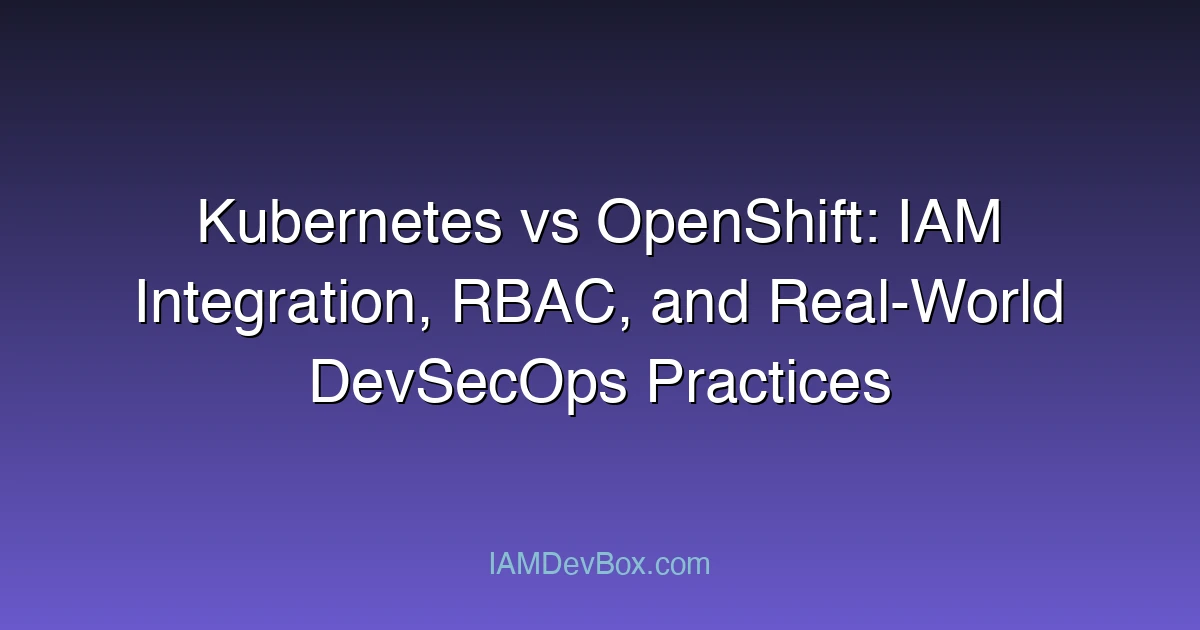Visual Overview:
graph LR
subgraph JWT Token
A[Header] --> B[Payload] --> C[Signature]
end
A --> D["{ alg: RS256, typ: JWT }"]
B --> E["{ sub, iss, exp, iat, ... }"]
C --> F["HMACSHA256(base64(header) + base64(payload), secret)"]
style A fill:#667eea,color:#fff
style B fill:#764ba2,color:#fff
style C fill:#f093fb,color:#fff
Introduction: Why IAM Matters in Kubernetes and OpenShift
In the modern DevSecOps era, Identity and Access Management (IAM) is no longer a secondary concern—it is foundational. As container orchestration becomes central to enterprise cloud strategies, the ability to control who can access which resources, and under what conditions, becomes critical.
Kubernetes and OpenShift are two of the most widely adopted platforms for orchestrating containerized workloads. While Kubernetes provides the core primitives for access control, OpenShift extends and enhances IAM capabilities, making it a popular choice for regulated or enterprise environments.
This post explores how these platforms handle IAM, compares their built-in mechanisms, and demonstrates how to integrate with enterprise-grade identity providers like ForgeRock.
Kubernetes IAM: Native Mechanisms and Integration
Service Accounts and API Access
Kubernetes uses ServiceAccounts to identify workloads (pods) and provides them with access tokens to interact with the Kubernetes API. For human users, Kubernetes does not have a built-in user management system; instead, it relies on external identity providers via OIDC.
# Define a ServiceAccount in the dev namespace
apiVersion: v1
kind: ServiceAccount
metadata:
name: app-sa
namespace: dev
Attach the ServiceAccount to a pod to allow it to authenticate to the Kubernetes API securely.
Role-Based Access Control (RBAC)
RBAC in Kubernetes lets you define who can perform what actions in which namespaces.
# Role binding for a specific user in a namespace
apiVersion: rbac.authorization.k8s.io/v1
kind: RoleBinding
metadata:
name: developer-access
namespace: dev
roleRef:
kind: Role
name: view
apiGroup: rbac.authorization.k8s.io
subjects:
- kind: User
name: [email protected]
apiGroup: rbac.authorization.k8s.io
This example grants view access in the dev namespace to a user identified by an external IdP.
OIDC Authentication Integration
To use OIDC with Kubernetes:
# Example flags added to the kube-apiserver
--oidc-issuer-url=https://idp.example.com/oauth2
--oidc-client-id=k8s-client
--oidc-username-claim=email
--oidc-groups-claim=groups
Once configured, your users can authenticate using tokens issued by the external IdP (e.g., ForgeRock or Ping).
OpenShift IAM: Enhanced Access Controls
OpenShift builds on top of Kubernetes and provides a robust built-in OAuth server. This enables:
- Native SSO login
- Integration with external IdPs (LDAP, GitHub, Google, OIDC)
- Web console and CLI identity propagation
OpenShift OAuth and External IdP Configuration
You can configure ForgeRock AM as an identity provider by adding an IdentityProvider resource to your cluster:
# Sample identity provider integration in OpenShift
apiVersion: config.openshift.io/v1
kind: OAuth
metadata:
name: cluster
spec:
identityProviders:
- name: forgerock
mappingMethod: claim
type: OpenID
openID:
clientID: openshift-client
clientSecret:
name: forgerock-secret
issuer: https://forgerock.example.com/am/oauth2
After this, users can authenticate to OpenShift using ForgeRock-issued tokens.
ClusterRoles and SCCs
OpenShift extends Kubernetes RBAC with Security Context Constraints (SCCs), enabling more fine-grained control over pod capabilities, such as running as root or using host networking.
ForgeRock Integration Use Case: Secure Dev Environments
ForgeRock AM can be used to manage authentication for:
- Kubernetes dashboards
- DevOps portals behind Ingress controllers
- API calls to the Kubernetes control plane
OAuth2 Proxy with ForgeRock
Use an OAuth2 Proxy in front of internal services:
[ForgeRock AM] → [OAuth2 Proxy] → [Ingress] → [Service]
This enables session-based or token-based access for internal applications using centralized policies.
IAM Best Practices in Multi-Tenant Kubernetes Environments
When building a multi-tenant environment on Kubernetes or OpenShift, consider:
- Namespace isolation per tenant
- ServiceAccount per application deployment
- NetworkPolicy enforcement
- Read-only dashboards per team
- Use of external IdP claims to drive role bindings dynamically
IAM in CI/CD: GitOps + Identity-Aware Automation
When applying GitOps or CI/CD workflows (e.g., with ArgoCD, FluxCD, or Jenkins):
- Ensure your CI agents use least privilege via ServiceAccounts
- Authenticate against the Kubernetes API using JWTs from trusted IdPs
- Use short-lived tokens for automated access
This reduces the blast radius in the event of a token leak or compromise.
Future Trends: Zero Trust, SPIFFE, and Workload Identity
The industry is moving toward zero trust in cluster environments. Standards like SPIFFE/SPIRE enable workload identity with cryptographic guarantees, moving beyond static secrets or tokens.
Expect to see:
- Wider support for federated identities
- Policy-as-code controlling access via claims (OPA/Gatekeeper)
- Cluster mesh identity coordination across multi-cloud setups
🎯 Key Takeaways
- Integration with external IdPs (LDAP, GitHub, Google, OIDC)
- Web console and CLI identity propagation
- Kubernetes dashboards
Conclusion
Both Kubernetes and OpenShift offer powerful IAM capabilities, but OpenShift provides a more integrated experience out of the box, especially for enterprises. Integrating a central identity provider like ForgeRock enhances auditability, security, and usability in complex environments.
By combining external identity platforms with native RBAC, IAM engineers and DevSecOps teams can implement secure, scalable, and manageable access control for Kubernetes-native infrastructure.
